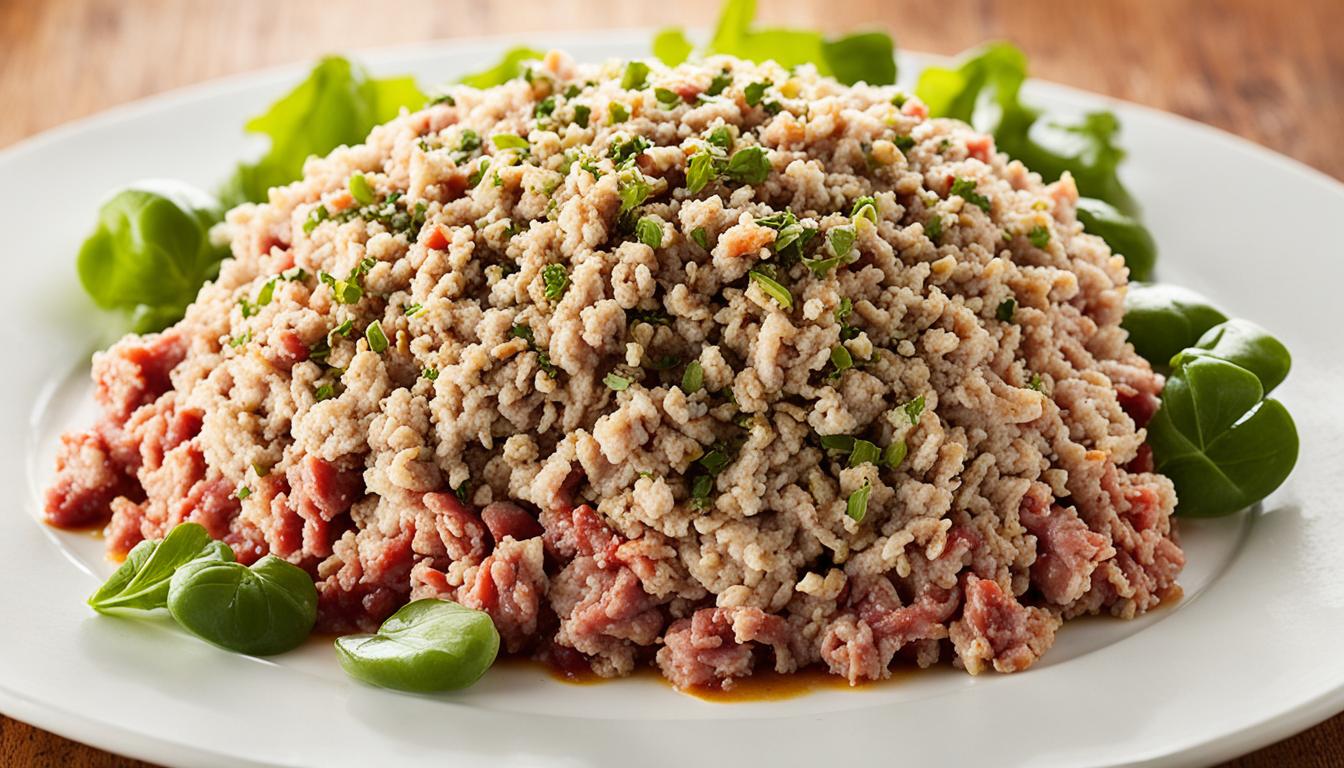Ground turkey is a popular choice for many. But it can spoil if not stored right. Knowing how to spot bad ground turkey is key. This will help you keep your meals safe and tasty.
A bad smell is the first sign of spoiled ground turkey. It should smell light, not strong or sour. A bad smell means bacteria have grown. This meat is not safe to eat.
The feel of ground turkey also matters. It should be moist but not slimy. If it feels sticky or mushy, throw it out. Doing so keeps you safe from getting sick.
Look at the color of the ground turkey too. Healthy ground turkey looks pinkish. If it turns dark gray, it’s gone bad. Also, watch out for any bad colors in the liquid in the package.
Cooking ground turkey right is crucial. It should reach an internal temperature of 165°F (74°C). This kills harmful bacteria. A food thermometer can help you check this.
Good handling stops ground turkey from getting contaminated. Always wash your hands after touching raw meat. Keep raw and cooked meat apart to avoid spreading germs. Clean all surfaces and tools well.
Storing ground turkey right keeps it fresh. Keep it in the coolest part of your fridge. Wrap leftovers well to keep air out. Freeze it if you’re not going to use it soon.
Ground turkey doesn’t last forever. Uncooked, it’s good in the fridge for 1-2 days. Cooked ground turkey can stay for 3-4 days. If frozen, uncooked turkey lasts 3-4 months, cooked lasts 2-3 months. Always check for spoilage signs before eating.
Key Takeaways:
- Pay attention to the smell, texture, and color of ground turkey to identify spoilage.
- Cook ground turkey to an internal temperature of 165°F (74°C) to ensure it is safe to eat.
- Practice proper handling techniques to avoid cross-contamination.
- Store ground turkey in the coldest part of the refrigerator and use it within the recommended timeframes.
- When in doubt, discard ground turkey that shows signs of spoilage.
Smell: The First Indicator of Spoiled Ground Turkey
Knowing if ground turkey is spoiled starts with its smell. It should smell mild when fresh. But if it smells bad, like sour or sulfur, it’s not good anymore. These smells mean bacteria has grown, making it unsafe to eat.
“If your ground turkey gives off a pungent, sour, or sulfur-like smell, it’s a sure sign that it has gone bad.”
Always sniff your ground turkey once you open it. If it smells odd, throw it out. It’s better to be safe. Using your nose helps keep you from eating spoiled turkey.
Common Off-Flavors and Their Meanings
Sometimes ground turkey tastes off but isn’t spoiled. Here’s what different off-flavors might mean:
- A “gamey” or metallic taste could mean it’s starting to go bad.
- Ammonia smells may indicate bacteria.
- If it tastes rancid or fatty, it might have been stored too long.
If your ground turkey tastes strange, it’s safer to throw it out. Eating it could make you sick.
Protect Yourself by Trusting Your Nose
Keeping an eye on how your ground turkey smells is key. If it smells off, it’s probably not safe to eat. Remember, if you’re unsure, it’s best to not take the risk.
Texture: A Slimy Feel Indicates Spoilage
The feel of ground turkey tells us if it’s spoiled, besides its smell. Fresh ground turkey feels moist but never sticky or slimy. A slimy layer means the turkey might be bad. Try breaking it apart to see. If it’s hard to separate or mushy, throw it away.
“If the outer layer of the ground turkey has a slimy texture, it is a clear sign that it has gone bad. To confirm, you can try breaking apart the ground turkey. If it is difficult to separate or feels mushy, it is best to discard it.”
Color: Darkening or Dulling Indicates Spoilage
The color of ground turkey tells us if it’s still good. Fresh ground turkey looks pinkish, showing it’s fresh and good to eat. But, if the ground turkey turns a dark gray color, it means it has spoiled. This color change is caused by bacteria growing in the meat.
Also, check the liquid in the package for any changes. This is another hint that the ground turkey might not be safe to eat. Remember, ground turkey should look bright and pink to be safe for cooking and eating.
“The color of ground turkey should be pinkish when fresh. If it darkens or dulls to a dark gray color, it has likely gone bad due to bacterial growth.”
Cooking Temperature: Ensure Proper Cooking to Kill Bacteria
Cooking ground turkey right is key. You need to heat it enough to kill any harmful bacteria. This makes sure it’s safe to eat.
The USDA recommends cooking ground turkey until it reaches an internal temperature of 165°F (74°C). This is the safe level to get rid of dangerous bacteria, preventing foodborne illnesses.
To check your turkey’s internal temperature, use a food thermometer. Put it in the meat’s thickest part, avoiding bones or the pan. When it hits 165°F (74°C) or more, it’s safe to enjoy.
Cooking your ground turkey to the right temperature helps kill bacteria. This cuts the chance of getting sick from undercooked or bad meat.
Tips for Cooking Ground Turkey to the Proper Temperature
- Use a food thermometer to get the right internal temperature.
- Insert the thermometer into the meat’s thickest part, steering clear of bones and the pan.
- Try not to overcook the turkey to keep it juicy and tasty.
- Make sure the thermometer is clean and accurate for the best reading.
- When adding other ingredients or sauces, ensure the turkey still reaches 165°F (74°C) for safety.
“Cooking ground turkey to the proper temperature is vital for food safety. By sticking to the guidelines and using a food thermometer, you can have delicious, safe ground turkey meals.”
Remember, right cooking temperature is only part of keeping ground turkey safe. Also, store, handle, and check the meat for any bad signs. With these steps, you’ll enjoy your turkey dishes safely and confidently.
| Ground Turkey Dish | Internal Temperature |
|---|---|
| Hamburgers or meatballs made with ground turkey | 165°F (74°C) or above |
| Ground turkey stuffing or casseroles | 165°F (74°C) or above |
| Ground turkey chili or sauces | 165°F (74°C) or above |
Safe Handling Practices: Prevent Cross-Contamination
Handling ground turkey the right way is key to keeping your meals safe. You can stop bacteria from spreading and cross-contamination by following these tips:
1. Wash Hands Thoroughly
It is very important to wash your hands well after touching raw or bad ground turkey. Doing this removes bacteria from your hands. This stops harmful germs from spreading to other places and foods.
2. Keep Raw and Cooked Turkey Separate
Always keep raw and cooked ground turkey apart. Use different boards and tools for raw and cooked meat. This stops bacteria from raw turkey getting onto cooked foods and making people sick.
3. Clean All Surfaces and Tools
Make sure to clean anything that raw ground turkey touches. Wash boards, knives, and counters with hot, soapy water. This gets rid of bacteria and stops them from getting on other food.
4. Store Properly
Storing ground turkey right keeps it fresh and stops it from going bad. Put it in the coldest part of your fridge, like the meat drawer or back bottom shelf. This keeps the meat at a good, cold temperature and makes it last longer.
5. Use Airtight Containers
If you’re not going to use leftover ground turkey right away, keep it in airtight containers or wrap it well in plastic. This keeps air out and makes the meat stay good longer, lowering the chance of it spoiling.
By care with these handling tips, you’ll keep your ground turkey safe and reduce the chance of it going bad. These easy steps help you eat with peace of mind, knowing your food is safe from cross-contamination.
Storage Guidelines: Keep Ground Turkey Fresh
To keep your ground turkey fresh, proper storage is key. Follow these tips to ensure your ground turkey remains safe and tasty:
- Refrigeration: Put ground turkey in your fridge’s coldest part, like the meat drawer or the bottom shelf at the back. It helps keep a cool, steady temperature. This extends its freshness.
- Proper Packaging: After opening ground turkey, wrap any leftovers tightly with plastic wrap. Or put them in a sealed bag or container. This keeps air out and stops spoilage.
- Freezing: Not using your ground turkey within 1-2 days? Freeze it. Make sure it’s in an airtight container or freezer bag. This prevents freezer burn.
Stick to these storage steps to keep your ground turkey fresh longer. Then, you can enjoy it in many delicious dishes without worry.
Shelf Life and Freezing Guidelines: Know When to Toss or Freeze
Ground turkey doesn’t last long and can go bad if you don’t eat or store it right. It’s key to know how long ground turkey stays good. You also need to know when to throw it out or freeze it for later.
Per the USDA, you can keep uncooked ground turkey in the fridge for 1-2 days. Use it within this period to keep it fresh and avoid it spoiling. Cooked ground turkey, however, lasts 3-4 days in the fridge.
Got too much ground turkey? Consider freezing it to make it last longer. You can freeze uncooked ground turkey for 3-4 months. Cooked ground turkey can be frozen for 2-3 months. Make sure to use airtight containers or freezer bags. This helps prevent freezer burn and keeps it in good shape.
When using stored ground turkey, look for bad smells, slimy texture, or color changes. These signs mean the turkey has gone bad. If you see these signs, throw the turkey away to avoid getting sick.
Tips for Freezing and Thawing Ground Turkey
Here are some tips to keep your ground turkey good when freezing and thawing:
- Freeze ground turkey in small amounts. This makes it easier to thaw and use just what you need.
- Mark your containers or freezer bags with the freezing date. This helps track how fresh it is.
- Thaw frozen ground turkey in the fridge overnight or use your microwave’s defrost setting for a quick thaw.
- Don’t refreeze ground turkey after thawing. This keeps bacteria away and maintains its quality.
| Type of Ground Turkey | Refrigerator Storage | Freezer Storage |
|---|---|---|
| Uncooked Ground Turkey | 1-2 days | 3-4 months |
| Cooked Ground Turkey | 3-4 days | 2-3 months |
It’s vital to know about shelf life and storage for ground turkey. This ensures your meals are safe and tasty. By following these guidelines and using smart freezing and thawing methods, you’ll reduce waste. Plus, you’ll get the best from your ground turkey, keeping it fresh and safe.
Conclusion
Knowing when ground turkey has spoiled is key to food safety. You want to enjoy meals that are fresh and tasty. Look at the smell, texture, and color of the turkey. How it’s cooked and stored also matters.
Always follow guidelines to keep food safe. This prevents spreading germs. If you’re unsure if the turkey is still good, it’s safer to throw it away. Good practices ensure your meals are safe and delicious.





